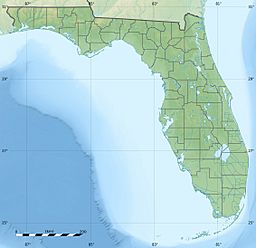Lake Hell 'n Blazes facts for kids
Quick facts for kids Lake Hell 'n Blazes |
|
|---|---|
| Location | Brevard County, Florida |
| Coordinates | 28°01′16″N 80°47′37″W / 28.021130°N 80.793669°W |
| Basin countries | United States |
| Surface area | 381 acres (154 ha) |
Lake Hell 'n Blazes is a special lake in Florida. It's also known by the names Hellen Blazes or Helen Blazes. This lake is very important because it is where the famous St. Johns River begins!
You can find Lake Hell 'n Blazes in Brevard County, Florida. It's about 10 miles (16 km) southwest of the city of Melbourne. The lake itself covers about 260 acres (105 hectares) of water.
Contents
Why is it Called Hell 'n Blazes?
The unique name "Hell 'n Blazes" comes from a long time ago, in the early 1900s. Fishermen used to say "Hell 'n Blazes!" because it was so hard to steer their boats through the lake. This was due to many floating islands that moved around. The lake was also in a very remote and wild area back then.
The other names, "Hellen Blazes" and "Helen Blazes," are softer ways of saying the same thing. They are like polite versions of the original name.
How the Lake Changed Over Time
Originally, Lake Hell 'n Blazes was part of a huge, wet area called a marshy floodplain. This floodplain was very wide, stretching about 10 to 20 miles (16 to 32 km) across.
As farming grew in the area, people dug canals to drain water away. These canals sent water into the lake. Because of this, the wide marshes around the lake became much smaller. They were only about 3 miles (5 km) wide near the lake.
When there was a lot of rain, large amounts of polluted water would flow into the lake. This started to cause problems for the lake's health.
Fishing and Environmental Concerns
Lake Hell 'n Blazes used to be famous for its amazing bass fishing. Many people thought it was one of the best bass fishing spots in all of Florida!
However, by the 1970s, the lake started to decline. The bass fish stopped laying their eggs (spawning) in the lake. It became rare for bass to even enter the lake.
By 1992, the lake was filled with too many plants like hydrilla and water hyacinth. These plants can make it hard for other life to thrive. By 1994, the lake had become very shallow, with only a foot or two of water. This meant the famous floating islands that gave the lake its name could no longer float freely.
In 1992, a report suggested that cleaning out the mud and dirt from the bottom of the lake would help bring the bass fish back. This process is called dredging. However, as of 2006, money had not been approved to start this important cleaning project.
Nearby Archaeological Site
The Helen Blazes archaeological site is a special place nearby where scientists study the past. This site was named after Lake Hell 'n Blazes.



